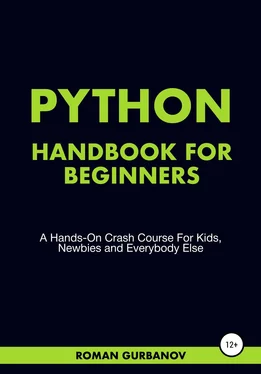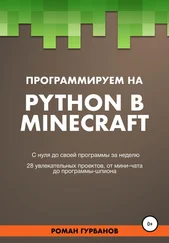Roman Gurbanov
Python Handbook For Beginners
1 How To Work With This Book?
This book suggests 11 themes that, once mastered, will give you basic skills in Python programming. These themes are arranged according to their difficulty level, from simple to more complex. If you wish to skip chapters, you are welcome to do so but bear in mind that every chapter contains concepts given in preceding chapters.
To get the most of this book, I highly recommend creating your version of every code given in the book. Tweak the code and see how it affects the output of the program.
It is also highly recommended that you take every test given at the end of chapters. Should you stack anywhere, you can always refer to the test answers given at the end of the book. But don't go there too soon. Take your time and reattend past topics.
Finally, it's worth mentioning that you don't need to install any software to write and run your code as you navigate through the book. You can use the free Python compiler (a program to write and run code), available here: https://online.qiber.org/code. No need to register or log in. I will be using this compiler in the book, and you may feel free to do the same. Should you decide to use other Python compilers, go ahead! There are many excellent, free compilers on the web. Here are some of them:
https://www.programiz.com/python-programming/online-compiler/
https://www.onlinegdb.com/online_python_interpreter
https://www.w3schools.com/python/trypython.asp?filename=demo_compiler
I am not affiliated with the above compilers and don't take any credits for them. I just want to give you some help diving into practical coding as soon as possible.
Python is one of the easiest to learn, yet, one of the most popular and widely used programming languages.
I would recommend Python as the first programing language to anyone who wants to learn to code. Why?
Python has a clean, minimalistic syntaxis. That almost looks like a natural language, which makes it easy to write and read the code.
It can take just a few lines of Python code to write a small script that does something. Simultaneously, it would require dozens of code lines in Java or C++, for instance, to complete the same piece of code.
Python is a high-level programing language, which means that it automates many essential tasks, such as memory management, which helps you focus on the core functionality of the program you create.
Python is extremely popular in the real world. Think of Google, Instagram, Netflix. They all use Python in areas that involve machine learning, data structuring, and processing.
Python is truly universal. Not only it works excellent for data-related scientific tasks. But you can build web apps and games too. Thanks to the respective Python frameworks.
Lastly, Python has a loyal and ever-growing community of supporters. Meaning the scale for Python application and the level of quality and efficiency of software built with Python will only grow.
In 1980, Guido van Rossum, a fellow at the Dutch CWI, set out to develop a powerful yet easy-to-read programming language.
Guido was developing Python in his spare time for one of the projects that required a scripting language.
While working on it, Guido borrowed some groundwork from another programming language that he was also developing. It was ABC language, created to teach programming.
Today Python is a popular, versatile, and mature programming language with many rich application libraries and extensions.
Professional programmers use it for various fascinating projects and support the language as a part of the global Python community.
Although professionals use Python, it is ideal for beginners. It helps schoolchildren, students, and simply novice developers take their first steps into the world of programming.
By the way, Guido named it so not in honor of the well-known snake species but the once-popular comedy TV show "Monty Python's Flying Circus." However, the language is still associated with the snake, reflecting snakes heads on its logo.
4 What Can You Create With Python?
Today, Python is used in various applications, including social media, artificial intelligence, and games like Civilization, Battlefield, World of Tanks, etc. Let's take a closer look at the examples.
Social Media
Billions of people use services like Facebook, Instagram, Reddit, Pinterest, and Quora. All of the mentioned services implement Python and its powerful features for data processing.
Search Engines
Major search engines like Google, Yahoo!, Yandex, Mail.ru use Python in their products for the same reason as mentioned above. Python is very efficient for data processing and management. It's also a dominating programming language for artificial intelligence algorithms that comprise a considerable part of search engine services.
Video Games
Popular video games like Civilization, Battlefield, and World of Tanks use this Python in their architecture. Its application is growing in game development due to the constant improvement and release of specific Python game dev frameworks and libraries.
Streaming and Cloud Storage
Youtube, Netflix, Spotify, and Dropbox use Python. Worth mentioning that Guido van Rossum has been working in the Dropbox company from 2013 until his official retirement in 2019.
Space And Neural Network
NASA uses Python in their Workflow Automation Systems, while SpaceX uses Python for testing.
Tesla uses Python too. Its developers build Autopilot neural network initially in Python for rapid iteration; Python's syntaxis is clean and minimalistic. It allows building and testing functional prototypes fast.
CHAPTER ONE: LET’S GET CODING!
1 Your First Line Of Code
Any, even the most advanced python program, starts with the first line of code. Here is an example of a simple program that has just one line of code. The only thing the program does is it outputs the message: "Hey! This is my first line of code!"
Open the console and write the following:
print("Hey! This is my first line of code!")
Don't worry. We'll learn what this code means in the following chapters. Now it's essential to get you going! When done, run the code by hitting the green play button. Here is the result you should get:

Well done! You've just started and have already written your first simple program.
Even if it was just a single line of code, we've created a program. Like those that make computers work.
But what is a program? A program is a set of instructions and rules for a computer written in a programming language. If that makes sense, let's go on and reinforce what we have learned. Here is the code I've shuffled. It will help if you put it so that it would make it work.
"Once upon a time…!" () print
If you put it right, you should get a program that prints a sentence. Here it is below.

Are you done with the task? Great! In both programs that we have just created, we used a print function. We will use it a lot in this book. But first, let's dive a little deeper into it.
Читать дальше














